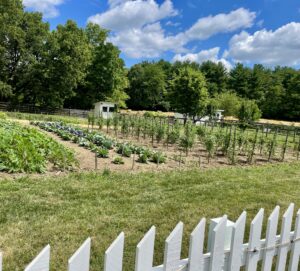Sensory Trails and the Writing of Memoir
 On Saturday, Cathy and I drove out to a living historical farm. The weather was pleasant—temps in the low-80’s with little humidity—and it was a pleasure to get out into the country. We walked up a lane along a field where a man was using a reaper-binder to assemble wheat shocks. We passed the chicken pen where a very vocal rooster was crowing. We looked at the large vegetable garden just outside the farmhouse. Everything took me back to my youth when I lived with my parents on our farm in southeastern Illinois.
On Saturday, Cathy and I drove out to a living historical farm. The weather was pleasant—temps in the low-80’s with little humidity—and it was a pleasure to get out into the country. We walked up a lane along a field where a man was using a reaper-binder to assemble wheat shocks. We passed the chicken pen where a very vocal rooster was crowing. We looked at the large vegetable garden just outside the farmhouse. Everything took me back to my youth when I lived with my parents on our farm in southeastern Illinois.
Watching the man at his labor in the wheat field took me back in time to the days I’d helped my father with the harvest. Only now, I could see what I’d been too self-absorbed to understand then—how hard my father had worked and how, despite the toll on his body, he’d loved it all. My mother had worked hard, too. As a small boy, I’d gone with her to gather eggs from the henhouse. I’d played with my toy trucks at the edge of our garden while she ran a tiller up and down the rows or built teepees with four stakes made from tree branches for our Kentucky Wonder pole beans to wind around or bent her back to pick whatever vegetables were ready. Later, I watched the sweat pool in the hollow (the suprasternal notch) of her throat as she canned tomato juice and green beans. I remember the heat of the kitchen, the whirr of an oscillating fan, and the pops of the lids as the jars sealed.
 At the living historical farm’s corn crib, had I wanted, I could have shelled an ear or two. The smell of the kernels and the discarded red cobs didn’t just remind me of the crib at one end of our barn, it gave me the feeling of being there on a raw October day when I was five years old, and I stood in my father’s wagon and threw ears through the crib’s high windows so we could have corn through the winter for our hogs. I remembered my mother’s headscarf and her Dickies work jacket and how they carried the faint scent of the kerosene she toted in five-gallon DX cans to use in our heating stoves—all that and my own corduroy coat and the way it felt when I ran my fingers over the wales.
At the living historical farm’s corn crib, had I wanted, I could have shelled an ear or two. The smell of the kernels and the discarded red cobs didn’t just remind me of the crib at one end of our barn, it gave me the feeling of being there on a raw October day when I was five years old, and I stood in my father’s wagon and threw ears through the crib’s high windows so we could have corn through the winter for our hogs. I remembered my mother’s headscarf and her Dickies work jacket and how they carried the faint scent of the kerosene she toted in five-gallon DX cans to use in our heating stoves—all that and my own corduroy coat and the way it felt when I ran my fingers over the wales.
I could go on and on, one sensory detail leading to another. And not only details, but the memories attached to them, not to mention the people. Writing memoir is always an act of resurrection. We revisit the past to make it vivid on the page. We relive what we’ve already lived because the writing allows us to dramatize, spectate, participate, reflect, interpret, interrogate, speculate, and imagine. This work is done in the service of making meaning as we look back on where we’ve been. As we move from reliving significant moments to thinking about those moments, we come to know what we couldn’t understand then. What better way to start that journey into the past than by way of sensory details? What are yours? What takes you back into the past? Perhaps, certain sounds, tastes, scents, or the way something felt when you touched it? Follow your own sensory trail to a time in your life that invites your further examination. Maybe you’ll even get lucky, like I did, and you’ll find a place near you that has exactly what you need to see, hear, smell, and feel.
Yes, Grademiners is safe. I’ve used their service several times and found them reliable. They deliver high-quality work on time, and their customer support is responsive and helpful. I’ve never encountered any issues with plagiarism or security. Highly recommend for anyone needing trustworthy academic assistance.
Lovely, lovely always graceful writing. Really enjoyed this vivid collection of sensory writing!
Thanks, Virginia!